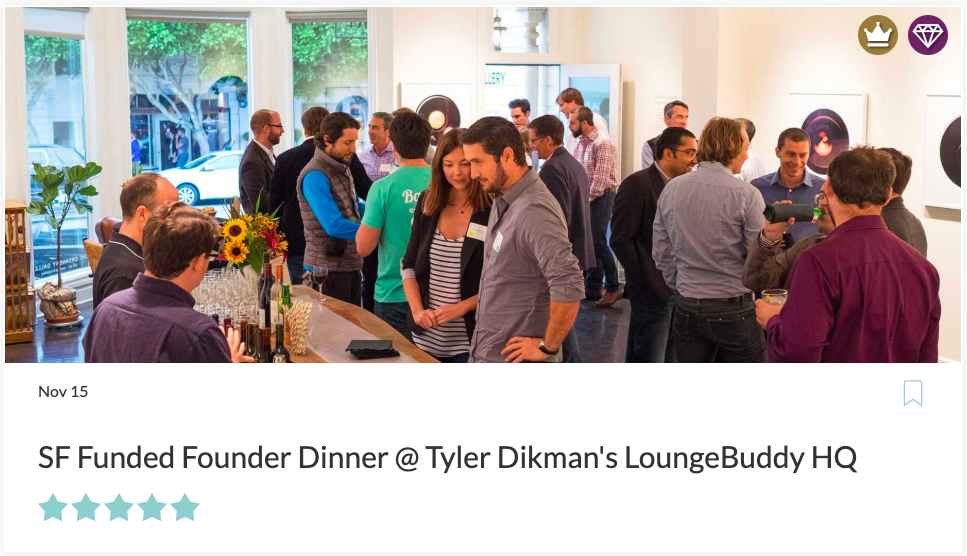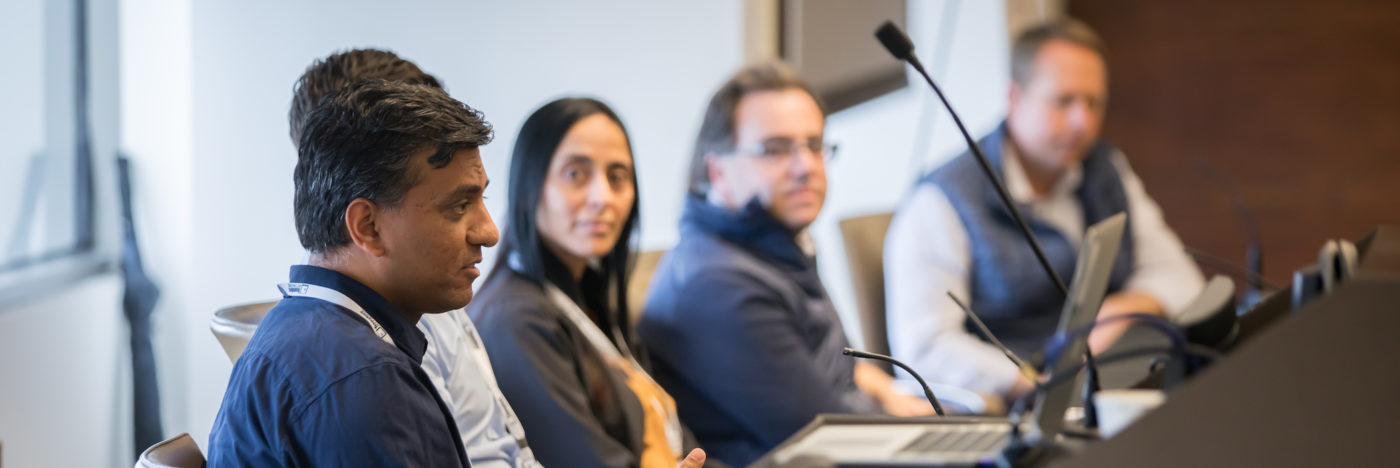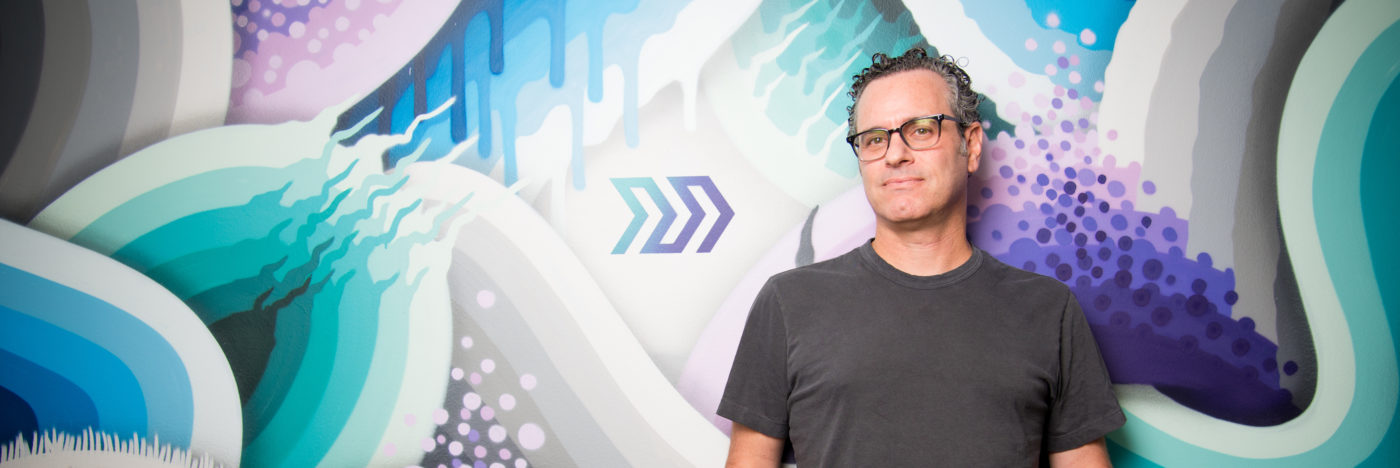
In June 2013, Tyler Dikman joined Founders Network with a project in beta called LoungeBuddy: A way for all travelers to discover, book and access airport lounges for the best airport experience — no need to be card members, elite status, or first class. Six years, 30 employee hires, and a Seed and Series A funding round later, LoungeBuddy was acquired by American Express in March 2019.
“When I reflect on my time in FN, I ask myself: would I do it all over again? 100%. Could I be more pleased with the outcome? Absolutely not. Truly a dream come true, and it is not a cliché to say that.
As founders, we often get so wrapped up in Silicon Valley’s culture, with everyone comparing numbers. But the fact that you are an entrepreneur, and providing a positive impact on millions of people with your startup— that’s what counts. That our team of 30 has helped millions of travelers improve their experience, and that we got acquired by a Fortune 500 company, that’s what I care about. And we had fun doing it.
As a founder, make sure that what you sign up for is something you really, really enjoy. Because some days won’t be so great, and the only thing that will get you through it is that you are passionate about what you are building.” said Tyler when asked about the last 6 years.
Finding product-market fit
Dikman’s beginnings with LoungeBuddy weren’t all that different from your average startup. In his first post to our founder’s forum, he surveyed Founders Network members while deep in R&D mode.

Then, Tyler asked The Network to test his beta product:
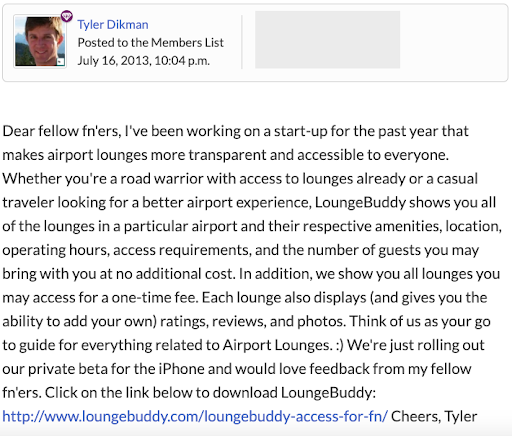
Getting featured on page 1 of the Apple App Store
After a year of building and optimizing his product, LoungeBuddy launched and immediately ended up on the front page of the Apple App Store.
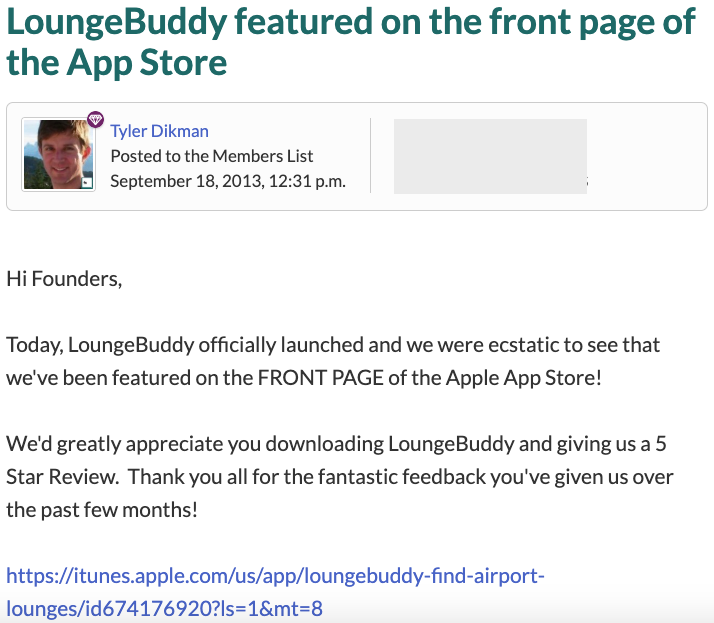
Being featured in digital media will almost always yield better returns
After this initial success, Tyler gave back by hosting a webinar on how he secured a spot on the front page of the Apple App Store. His learnings:
- Build your app using Apple’s latest design standards and functionality
- Make sure it’s globally accessible
- Make sure it’s unique
- Make sure it’s free
- Make sure it’s exclusive to iOS, at least for the initial release
“A couple of things I learned about features and media, in general, is that being featured in digital media (if you’re consumer-focused) will almost always yield better returns than print or television media. It’s great to get featured in the Wall Street Journal or CNBC, but if there’s not a digital version attached to it, you’re not going to get as good of an ROI as if you were featured on the App Store or if an influential blogger talks about your service.”
“For us, our returns were bigger when an influential travel blogger talked about us and compared to when we were in the print edition of GQ. For a guy like me, who is the exact opposite of cool, it felt amazing to be featured in print or TV, but the return just was not as high.
Getting on the app store is all about creating a service focused on using Apple’s cutting-edge design standards, and their latest and greatest functionality. For example, recently, Apple released the new version of iOS standards: if you want to get featured now, create a cool app that utilizes those design features, make sure it’s globally accessible, and release.
Almost always, the editors will consider that product for being featured. But you have to make sure it’s a product that is multinational, that is unique, and figure out what your category is and make sure you’re super differentiated in that category.
Also, ideally, your app should be free or at least you don’t have a forced sign-up as soon as a user opens the app. Users should be able to use some functionality without having to register and/or pay. And Apple likes exclusively iOS products. So we initially launched on iOS, then Android.”
Build a unique brand
“One of our early reasons for success was that we had a unique product, that was well-designed. It was very niche, but it was a niche that people wanted to be a part of. Either you have access to lounges already and gloat about having it, or you don’t have access, and you probably wish you did.
So having a product that gets you connected in with that, it’s an aspirational thing, even if you never buy access from it. That unique factor was a significant way that we built up our initial customer base.”
For the first year or so, we weren’t selling anything, we were just a directory and community. But that allowed us to build our brand and partnerships, and become a name in the industry. Which then allowed us to go out and sell to partners eventually.
There are a ton of companies in the travel industry that claim to be innovative, but frankly, most of the industry is old school and behind the times, and operating on very, very old infrastructure. Plus, they’re very conservative and risk-averse. So because of that, if you’re some hot startup that walks into a room, you’ve got to be able to do more than just say “we have a pretty looking app”.
Know your customer, know your sales cycle
“Companies don’t want to partner with a startup that could run out of money in the near future. The sales cycle into those larger companies is very long– expect a cycle of 12-36 months. You could pitch them today, and they could say: “Wow, let’s get the executive team in here and talk”… then more meetings.
Later on, after all those meetings they say: “Let’s touch base every quarter, but we just missed our annual planning, so let’s regroup in a year and see if we can get it in for the next year”. And by the time you get to the next year, you may get in the budget. Or, the initial people you met with may have moved to another position in the company, or left the company, and you have to start from scratch.
Almost all our mid to large deals were over a year, and one of our largest was two and a half years.”
Stay frugal
“Throughout that whole process of not selling anything, we were crazy frugal. We operated the entire company for two and a half years and spent six figures. And we had a team to pay — not a huge one. I paid myself very, very little, certainly not enough to cover all my expenses in the city of San Francisco.
We were very transparent with the rest of the team about what my salary was, and how I was focused on equity and not cash. And I think I got a lot of respect for that. At the same time, we put a lot of work into designing the space we worked from and hiring the right people who valued the same things we valued. It’s not just about having cool stuff, it’s about working with people who want to be a part of what you’re building.”
Warm intros are still the best way to raise funds
“Given how nearly every person is directly accessible through AngelList, Facebook, LinkedIn, Twitter, etc., it’s still very much an intro-focused world for investors, and that’s just part of human nature. People are more likely to trust you if someone they currently trust introduces you to them. So when we started raising, the majority of the meetings set up were directly from warm introductions that were made.
I ask a lot of favors, and I have certainly offered the same of others, with the expectation that I am respecting the time of anyone I introduce. It’s important to me that I not waste anyone’s time. At the start, we raised some money from friends and family.
Fortunately, some of my friends are also angel investors. They were very helpful in not only putting in the first few bucks, but also in making warm introductions. This is the third VC-backed startup I’ve been a part of, but this was the first time I was directly responsible for raising the money.”
Fundraising is about storytelling
“Raising money is being able to take your concept and translate it into a story that people not only understand, but can get excited about. That is very difficult to do for many startups, because entrepreneurs want to talk about everything, or they think certain things are important. In reality, VC’s don’t want to know anything about that, so:
- Be concise
- Get your point across in the first 2 minutes of your pitch
That was a lesson that it took me a while to learn: unlike a stand-up comedian that’s up there for an hour and works up to the big jokes, founders should start with the punchline. If the person receiving your pitch is excited in the first few minutes, they’re going to want to listen to you for the rest of the presentation. But if you don’t get them excited from the start, even if you tell them the most exciting thing at the end, you may have already lost them.
It’s like watching a movie trailer. They are typically 45 seconds to 3 minutes long. Captivate your audience in that time, and if they get excited, they will want to see the whole movie.
For example, when I was raising my seed round, I met an investor through Founders Network— Daniel Hoffer. I pitched to Dan in the very early days, and I think it was a classic case of not telling my story in an exciting way. But later on, we reconnected, and I told the story in a different way, and I think he saw something he didn’t see before and got really excited about it after that.
Sometimes if you get a no, that doesn’t mean that you don’t eventually get a yes. He was initially an advisor, then after that became an investor. Try to get the advisors you value to make an investment in your company. Because if they have some skin in the game, they’re more motivated to want you to be successful.”

Daniel Hoffer
Founder
Couchsurfing
14M+ Users
Managing Director
Autotech Ventures
FN member since 2012
“I first met Tyler Dikman at a Founders Network event back in 2014 or so when the company was still very young (seed stage), and saw him again at a Concur event where he won a small business plan competition.
I couldn’t engage with him at the time because I was working in a corporate venture capital role that prohibited such activities, but after leaving that role, I reached out to him to explore an Advisor relationship. We agreed to work together in that capacity, and subsequently, I invested personally into his Series A.
Tyler delivered phenomenal execution, operating strategically with great discipline, precision, persistence, and frugality. I was very happy, though not at all surprised, when American Express ended up acquiring his company.” — Dan Hoffer.
Get used to hearing no
“We raised our seed money in convertible debt. That convertible debt was spread across approximately 20 investors. Of those 20 that ended up investing, I probably made 200 pitches easily. So you find a lot of rejection.
It’s frustrating, it can be painful, and it can be really depressing, especially when you are introduced to somebody you really admire, and you walk out thinking “either that person is an idiot, or I’m an idiot”. That’s not to say people are stupid because they don’t like your idea, but that is your initial reaction. It’s a real emotional rollercoaster.
It’s a VC’s job to invest in companies that they think are interesting, and if they flat out tell you they aren’t interested, that’s really tough.”
If you cannot present a scenario to an early-stage investor that they can expect a 30X return or higher, most will not be interested
“When you’re trying to raise from a VC, make sure that the VCs you’re talking to are willing and able to write a check of the size you’re asking for. VCs will almost always take a meeting, but there may be a 0% chance they will ever write you a check because the amount you’re asking for doesn’t align with their check size.
The real rule of thumb is that you have to understand their fund size. And if you are asking for less than 1% of the size of their fund, they probably are unwilling or unable to write that check. Now, some VCs may have a separate, tiny fund. The main fund may be $500M, with a separate seed fund that’s $20M. But if you pitch to the $500M fund and ask for less than $5M, that’s usually a no-go.
If you cannot present a very real scenario to an early-stage investor that they can realistically expect a 30X return or higher, most professional investors will not be interested. Friends, family, and angels are different. But VCs won’t be interested. And to some entrepreneurs, that’s irrational/insane.
When it comes to valuations, too, you need more than “we think we’re good, so we’re worth this much”. If you’re raising $2M at a $10M post-money valuation, you need a compelling story that explains how your company will be worth well in excess of $300M. And if you can’t tell that story with absolute certainty, you will most likely not find any professional investors willing to invest at a $10M post-money valuation.
The reason the size of the fund coincides with how much you’re asking for is that you as the entrepreneur are only betting on one company. At 30X, if the VC puts in 3% of their $500M fund, and you return 3X, you’ve returned the value of the fund (approx $500M) back to them.
If you ask for $1M out of a $500M fund, even if you return 30X, it’s a big rock, but in a massive ocean. And it’s a lot of work to keep an eye on a company. Most VCs are unwilling to put $1M into 500 companies. You need to be able to really align who you pitch to with their goals and the kind of check they can write, and the stage that the particular fund is in.
If you pitch an early-stage company to a VC in year 7 of a 10-year fund, it’s probably too late– they’re not going to write you a check, because they are supposed to return that money to their investors at year 10.
Another thing I wish I had thought about more carefully at the beginning is that most startups have an exit somewhere between 5 and 10 years after they’ve started. There are always exceptions to the rule, but if you look at most massive exits, it takes 5 years or more. Slack, Uber, Lyft, Zoom, are no exception to that, just look back to when they got started.”
Set up your company up to not need future investment
“After raising, I made it clear to everyone that we needed to assume that we might never raise again. The goal was to set our company up to not need future investment. The best companies don’t raise a lot, show early market adoption, and the remaining cash they get is focused on getting a positive ROI.
It needs to cost you less to acquire the customer than what they will give you in profit — hopefully in a relatively short period of time. And if you can figure out that formula, you’re set.
With each round you raise, you need to have a plan for how you can set yourself up to never raise another dollar again. Because with every dollar you take in, there are always strings attached. Raising money is not an accomplishment, building a solid business is the accomplishment. If you build a solid business with tremendous growth potential, the investment will come.
In my experience, once you’ve raised your first bit of cash, it’s easier to raise your later rounds. We had one third of the amount of meetings to raise our Series A than our Seed, and we raised a lot more for our Series A.”
The most valuable acronym a founder should know
I think the story of “here are some of the things you should bear in mind, particularly in the beginning” doesn’t get often told enough or with as much depth as it should.
QSBS is an example of that. It’s one of the most valuable acronyms for founders to know, and very few founders are familiar with it.
I’m talking about Qualified Small Business Stock. Note, I’m not a tax advisor or attorney, and it’s important to get advice from a qualified professional in this area.
The general overview is that at the time you start your company (i.e. when it is worth virtually zero), you buy your shares (not options). The company is a C-corp and you file your 83(b), keep records for actually buying the stock (i.e. a copy of your deposited check into the company’s bank account), and you hold the shares for at least 5 years. Then you can benefit from this very special opportunity.
Say that you and your co-founder start a company tomorrow. It is a C-corp and has zero value. You each get 40% of the company and each pays $400 for the shares. You receive your stock certificate, save a copy of your canceled check for $400 that is deposited into the company bank account, and file your 83(b). Five years and one day later, your company gets acquired for $25 Million.
Thanks to QSBS, you will pay ZERO federal tax on the greatest of 10X your investment (of $400) or $10,000,000 of proceeds. In this example, your payday will be $10 Million, which means your only tax burden would be state income tax (and in some states, you won’t be responsible for taxes on this income either).
For some founders, this means that waiting a bit longer to sell, may dramatically change your payday. In addition, buying your shares and filling out the right paperwork from the beginning can equal millions in tax savings. This is one example of having that knowledge early on can be the difference between having a very financially beneficial outcome, and having something that wasn’t bad but could’ve been a lot better.”
Having a smaller pie but a bigger piece of it yields higher returns for those with a piece
“The only other thing I’d really like to share, and one I would gladly tell founders in Founders Network: Some of the most successful businesses are the ones where the exit is not in the billions of dollars. First, most exits are not billions. Oftentimes, the exits that are most lucrative for the founders and early employees are smaller because then they did not give up a ton of equity to investors. Having a smaller pie but a bigger piece of it often yields higher returns.
A critical factor that most people underestimate, is who can afford to acquire your business, and at what price? Look at the big players (i.e. potential acquirers). Look at their past acquisitions.
To get the price tag you think, the only option is getting acquired by one company or filing an IPO. Take the number of IPOs in tech in the last ten years, and the number of startups in the last ten years who have raised a seed round, you will see that’s a small fraction of one percent. If the biggest potential buyer of your company hasn’t bought a company for more than $50M in the last few years, you probably won’t be the exception to that rule.”
If you take money from investors, you need to expect to have an outcome
“When we raised our Series A round, there was a general expectation of a liquidity event. To be clear, virtually all startup founders that raise more than friends and family need to have that same expectation. Of course, investors need to be able to get liquidity at some point unless you’re a charity. That liquidity could come from acquisition, a merger, or an IPO.
Once we started picking up cash, we began thinking through our exit strategy. That was soon after incorporating the business, a few months prior to launch, and less than a year after we came up with the idea.”
The best potential acquirers are businesses you’re currently working with
The best potential acquirers are businesses you’re currently working with. Just like with investors, people want to do business with people they trust. There’s this amazing book called Magic Box Paradigm that I highly recommend. This book is great for any startup founder who wants to understand how to best position their business to be bought and not sold.
Being bought and not sold is the difference between selling out of desperation and turning down an offer because you aren’t ready to sell at that point in time.
With our acquirer, we had been working with them for 2 years, and we have had several successful implementations. We were able to prove to them that their value proposition to their customers was very complementary to our value proposition.
Of course, AE (as well as any other company) could try to build what we’ve created, but they knew we could do it better and faster. Moreover, the two companies combined were greater than the sum of the parts. And just like in the movie Inception, you plant that seed in their head and let the idea take root. That’s part of that multi-year sales cycle I mentioned earlier.
You want to become friends with your potential acquirers early on. Even if they aren’t interested at first. Keep them warm, keep them interested and updated. Because a couple of years down the line, they may be talking to their board, and a problem will be brought up that your company can solve. Even if you aren’t a B2B business, you should understand who your potential acquirers are, and keep them up to date.
If you try to sell your business in less than a year, you have probably not given yourself enough time (and it likely becomes a fire sale). From the day you start a serious conversation about acquisition, to the day that sale happens, it’s almost never less than 4-5 months.
Almost always, the acquirer expects the key members of the team to stay on for at least a couple of years after. When you add it all up, you need to think: are you willing to put 5-7 years in to build and sell the business, and then stay on with your acquirer for another 2-3 years?
After LoungeBuddy’s acquisition, Tyler stayed at the company as the Vice President of Global Premium Products and Benefits for American Express. Today, Tyler remains an integral part of the Founders Network community. He hosts intimate dinners at his office, lists his product on our directory of deals, and will be giving a fireside chat about his acquisition at our Annual Fall Conference, fnSummit.
